
|   |

|   |
Atharvotsav ascends new heights - Shyamhari Chakra e-mail: shyamharichakra@gmail.com Photos courtesy: Atharva School of Fine Arts May 14, 2022 Mumbai, April 30: The excitement over the just celebrated World Dance Day was still in the air. Being a Saturday, the city was hosting a number of dance events as part of the celebrations. And for the dance connoisseurs, all roads led to NCPA - literally - for the grand finale of its famed annual Mudra dance festival. Against such a backdrop, it was a pleasant surprise to find the Mysore Association auditorium full to its capacity for the 13-hour marathon dance event - Atharvotsav - hosted by the city's lesser-known Atharva School of Fine Arts (ASFA). Into its seventh edition this year, the annual festival has been the brain-child of Bharatanatyam dancer Shamal Kanwalu Pawar who quit her white-collar job as a HR executive for over a decade to focus fully on dance. She founded ASFA in 2003 and started teaching Bharatanatyam to aspiring dancers. "The idea of hosting an annual dance festival originated in 2015. Thus, Atharvotsav was born to highlight ASFA's students and productions. However, after hosting it for two years, I thought of involving different dance institutions and dance traditions in the festival. The purpose was to educate my students about the broad canvas of Indian classical dances", recollected festival's founder-director-curator Shamal. Inclusion and involvement of Mumbai's dancers and dance institutions in the festival fetched host ASFA much appreciation, both from the dance circles and the government as well. The first festival grant came from Government of Maharashtra in 2017 and Indian Oil Corporation came forward as the festival's first sponsor next year. Government and corporate support apart, ASFA's well-wishers that included families of the dance and music students extended resource support for the festival and thus Atharvotsav could emerge as one of the city's known dance festivals in 2019 by featuring about 200 artistes that included several stalwarts like Manipuri exponent Darshana Jhaveri, Kuchipudi exponent Vyjayanti Kashi, Odissi exponent Debi Basu and Bharatanatyam exponent Lata Surendra. While Covid crisis forced the festival's halt in 2020, it went virtual last year and received rave response. With participation of dancers from across India and even one from abroad, the just concluded 7th edition of Atharvotsav ascended newer heights this year. The festival was a part of the world-wide celebration of 75 years of India's Independence and the International Dance Day as well. Further, the festival added a new feather to its cap by offering performance fee to the artistes in an era that is increasingly being plagued by the pay-and-perform syndrome. Care for the uncared for - this appeared as the focus of the festival this year. Unlike other festival curators who prefer stars, stalwarts and celebrities, festival director Shamal featured many gifted dancers who never had an opportunity to perform in Mumbai- like Santanu Roy from Kolkata, Sandhya Venkiteshwaran from Coimbatore, Swati Athmanathan from Chennai - and the dancers in disadvantage like the young mother Isha Rane from Mumbai whom we saw coming with her six-month-old baby in arms and the group of elderly dancers from Mumbai's Gitanjali Ensemble who have been mothers and grandmothers. The festival showcased five of the eight Indian classical dance traditions this year - Bharatanatyam, Kathak, Kuchipudi, Mohiniattam and Odissi. Bharatanatyam had the lion's share with 12 soloists and four group presentations followed by Kathak. The rest of the forms had minimal representations. 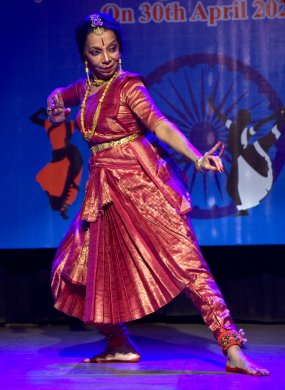 Lata Surendra Of all the soloists, senior-most artiste of the festival, Lata Surendra lived up to her reputation as a class of her own. The Mumbai-based celebrated performer-choreographer-curator-researcher and writer - also known as the dance guru of Bollywood celebrity Aishwarya Rai Bachchan - made us realise what Martha Graham meant when she had stated "Dance is the hidden language of the soul". Her portrayal of the love of a mother for her child was seen to be believed. With a quick and clear transition of emotions and transformation of the characters between the mother and the child, her captivating presentation left the audience awe-struck. Lata was not merely portraying the character of a mother but was the mother in flesh and blood - the dance and the dancer merging together on stage. The rest of the soloists in Bharatanatyam belonged to the new generation that is passionate of and committed to their career as professional dancers - Sujatha Ramanathan, Aishwarya Harish, Rewati Kulkarni, Chaitali Madkaikar, Samidha Shinde, Isha Rane (all from Mumbai), Sandhya Venkiteshwaran (Coimbatore), Pooja Hirwade (Nagpur), Santanu Roy (Kolkata), Swati Athmanathan (Chennai) and Ananga Manjari Malatesta Gonzalez from Peru, South America. 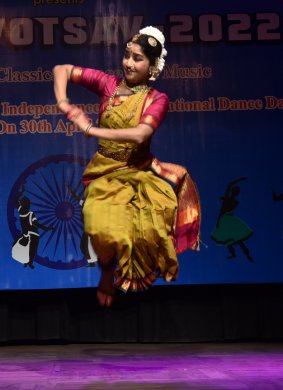 Sujatha Ramanathan 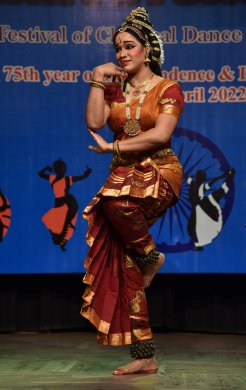 Aishwarya Harish Disciple of gurus Lata Raman and Adyar K Lakshman, Sujatha Ramanathan has grown up as a potential soloist and choreographer. Her concert comprised choreographies of Vaibhav Arekar and T K Mahalingam Pillai and concluded with her own choreography that was inspired by her visit to the prison in the Andaman Islands where great freedom fighters sacrificed their lives for freedom of the nation. It revolved round the concept of liberation as perceived by popular Tamil poet, freedom fighter and social reformer Mahakavi Subramanya Bharati. Daughter and disciple of Guru Jayashree Rajagopalan, Aishwarya Harish follows the legacy of legendary Padma Subrahmanyam, her mother's guru. Having had the fortune of being a part of Padma's productions, she has assimilated the essence of her style and has emerged as a soloist faithful to her legacy. The two choreographies of her mother and guru that she staged - Shankara Aala Sabhesa in Marathi written by Shahaji Maharaj recounting the arrival of Lord Shiva and Janaki Jeevan Ram, an excerpt from Tulsi Ramayan that portrayed episodes from the life of Sita from her childhood to wedding with Lord Rama. South American Bharatanatyam dancer Ananga Manjari Malatesta Gonzalez, who added an international character to Atharvotsav this year, is well-trained in western classical ballet and contemporary dance with years of experience. Yet, the Peru-based dancer has faithfully retained the flavour of typical Bharatanatyam in her body language that was impressive. Trained under three Bharatanatyam exponents -Shankar Kandasamy in Malayasia, Sonal Mansingh in India and Janaki Rangarajan, her present teacher in the USA, her articulation of kid Krishna's character was apt. 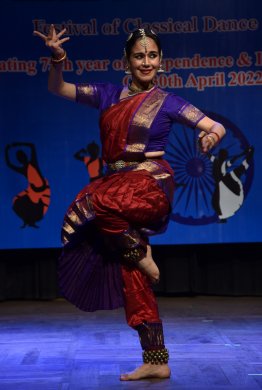 Ananga Manjari Malatesta Gonzalez 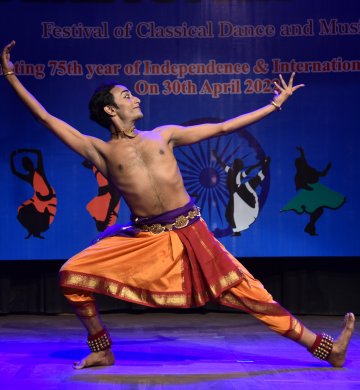 Santanu Roy The lone male soloist of the festival, Kolkata based Bharatanatyam artiste Santanu Roy has emerged as a potential solo dancer. Groomed by gurus Jalsa Chandra and Samrat Dutta in his home city, his devotion for Bharatanatyam led him to the land of Bharatanatyam for a master's degree from the Tamil University and guidance of maestro Prof. C.V. Chandrashekhar in Chennai. His concert that comprised an Alarippu and a Surdas bhajan with three excerpts from Krishna Katha (Tales of Krishna) spoke volumes of Santanu's grip over pure and expressional elements of dance. Like Santanu, his dance partner Swati Athmanathan has been another devotee of Bharatanatyam that drew her from the holy land of Kashi to settle down in Chennai, the Mecca of Bharatanatyam. Born and brought up in Varanasi, she started learning the nuances under her grandfather Prof. K.V. Krishnan. She later had her master's degree from the University of Madras and pursued training under Padma Subrahmanyam. Currently under the tutelage of Prof. C.V. Chandrasekhar and Jaya Chandrasekhar, the promising young dancer excelled in her presentation of Ardhanariswara choreographed by Janaki Rangarajan and a tillana choreographed and taught by her guru Prof. Chandrasekhar. Coincidentally, the tillana was composed by the guru while he was in the disciple's birthplace of Kashi and apparently Swati was quite excited about it. 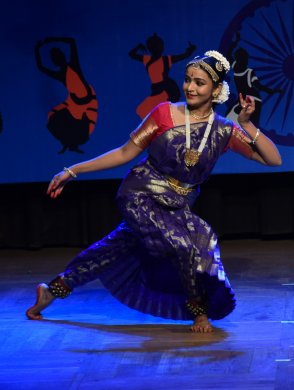 Swati Athmanathan 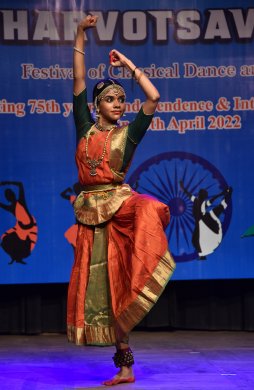 Sandhya Venkiteswaran An alumnus of the famed Kalakshetra in Chennai, Coimbatore's young dancer Sandhya Venkiteswaran impressed with her soulful rendition of Lord Shiva's Ananda tandava- the dance of ecstasy - in Yathi, a Sheejith Krishna choreography. For Chennai-born and Mumbai based Anupama Devarajan, the high profile tag of being an IIM Ahmedabad alumnus did not deter her determination to be a professional dancer. Trained in Bharatanatyam under Guru Jayanthi Subramaniam and currently under Geetha Venkateswar, she staged two choreographies that revolved round women. Similarly, Nagpur's Pooja Hirwade, disciple of Guru Ratnam Janardhanan, had an energetic portrayal of Kali, the blue goddess. A talented footballer who has the honour of representing various clubs in Mumbai, Rewati Kulkarni takes pride in introducing herself as a Bharatanatyam dancer. Disciple of Guru S.P.Srinivasan, the passionate dancer staged an involved concert. Chaitali Madkaikar, one of the proud products of Mumbai's well known Nalanda Nrityakala Mahavidyalaya and founder of Nrityasadhana Dance Academy, had a neat presentation of Ardhanareeshwara Ashtakam choreographed by Chennai based brilliant Bharatanatyam dancer Lavanya Ananth. Similarly, Samidha Shinde, disciple of Bharatanatyam exponent S.P. Srinivasan, also trained under legendary Kanak Rele at Mumbai's Nalanda Dance Centre, impressed with her guru's Mohamana Varnam choreographed with her crisp jatis. Mother of a six-month-old baby, Mumbai's young Bharatanatyam dancer Isha Rane Pravudesai won hearts with her exemplary commitment to dance as her passion and profession. She was seen taking care of the baby while waiting at the wings and performing Saveri jatiswaram at the next moment with intense involvement. The festival featured three Kathak soloists that included two eminent dancers from Mumbai - Manali Deo and Rupali Desai. Incidentally, both have been distinguished disciples of Guru Manjiri Deo and both preferred to present compositions of Pt.Bindadin Maharaj. Doubly blessed to have her guru as her mother-in-law apart from having tabla exponent Mukundraj Deo as her husband, Manali Deo has mastered a good grip over the art of rhythm that is so relevant to Kathak. Shyam Chabbhi, a classic composition portraying the leelas of Lord Krishna that she performed with elan has the finest of pure and expressional dance elements. Rupali Desai, also having the fortune of being trained under Manjiri Deo and Mukundraj Deo, staged a perfect recital of Kathak's traditional aspects - commencing with Vandana followed by thaat, amad, tode, paran, tatkaar and concluding with a thumri. 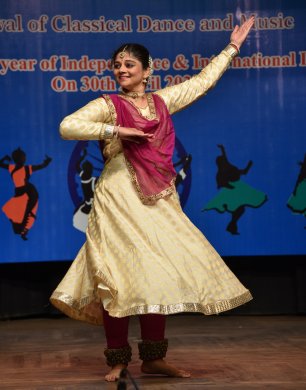 Neha Muthiyan Pune's Kathak dancer Neha Muthiyan, disciple of the distinguished Shambhavi Dandekar, proved that dance is not just drill or a mere exhibition and exploration of the body kinetic but beyond it all. Dancing from within and with dynamism, the artiste excelled in her abhinaya. Mumbai's established Mohiniattam soloist Sujatha Nair Sanjay, daughter and disciple of Guru Jayashree Nair, staged Ardhanaareeswara Ashtakam and concluded with an interesting Marathi Niroopan - a mock conversation between Siva and Parvathi. Like Mohiniattam, Kuchipudi has the lone representation in the festival with Mumbai's budding dancer Sindhuja Desai, daughter and disciple of Guru Sailaja Desai. 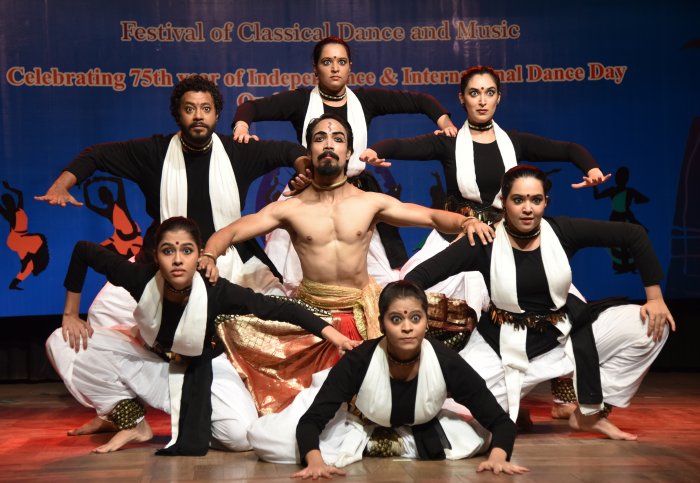 Manas Cultural Centre Among all the group presentations in the festival, Mumbai's Manas Cultural Centre had the most memorable presentation - Panchamukhi Hanuman. Led by its founder-director Manisha Jeet, the dancers stormed the stage and danced into the hearts of the audience - literally - with their peerless presentation. If Kathak is all about the art of story-telling, then Manisha excelled in it with her thought provoking concept, convincing script and creative choreography. Her production defined how innovations could be incorporated wisely within a tradition and how a production could be designed to woo the audience of diverse generations and tastes. The other two Kathak groups from Mumbai also impressed. Guru Rupali Desai's Sanskriti Kala Mandir troupe had excellent team work, aesthetically crafted costume, perfect synchronization of geometrical patters and well groomed dancers. Similarly, the bunch of budding dancers from Pallavi Muley Mhaiskar's Nrutyangan Kathak Dance Academy staged a neat concert. 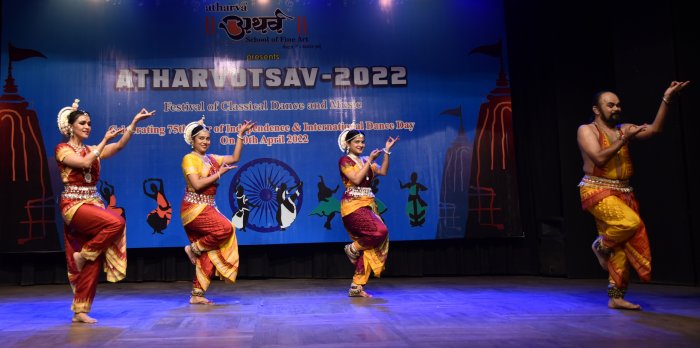 Smitalay ensemble Though Mumbai's celebrated Odissi exponent Jhelum Paranjape could not join the festival as a soloist as scheduled, representation of her legacy could be felt through her famed Smitalay Odissi Ensemble that staged two of her choreographies - Shiv Vandana and Kalavati Pallavi. 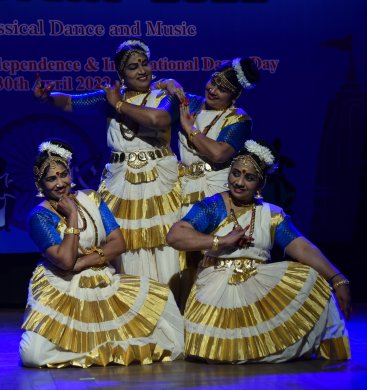 Gitanjali ensemble A group of four ladies who have just three years of training in Mohiniattam under Guru Geetha Vijayshankar's Gitanjali Dance School in Mumbai presented the popular choreography of Swagatham Krishna. More than their quality of dance, what touched hearts was their passion for dance. The pure joy of dancing was clearly evident in their faces that made a profound statement - that there is no age bar for a dancer. The three Bharatanatyam group presentations that the festival featured were by Mumbai-based dance institutions - Samidha Shinde's Institute of Performing Arts, Kashmira Trivedi's Takshashila Nrityakala Mandir and host Shamal Kanwalu Pawar's Atharva School of Fine Arts. As a befitting tribute to the land of Bollywood, the festival's fitting finale was a collage of dance pieces following the Bollywood style presented by the students of host ASFA. 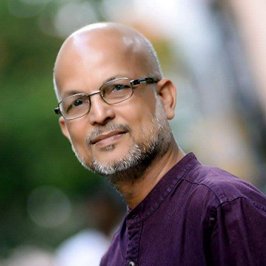 A former journalist and arts critic with The Indian Express and The Hindu for 20 years, Shyamhari Chakra is a New Delhi based independent writer on cultural affairs. |